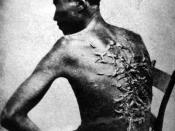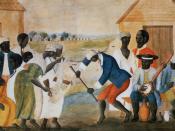Antebellum Slavery
Although most people in western Virginia were engaged in farming and livestock operations in which slavery was not economical, there were parts of the region which did use slave labor. In addition to the small farms, the South Branch, Greenbrier, Monongahela, and Kanawha valleys also consisted of larger farms of tobacco and other cash crops which used slaves. In 1860, there were 490,308 slaves (approximately 30% of the total population) in eastern Virginia belong to 48,308 slaveholders, averaging over ten slaves per owner. In western Virginia (including Eastern Panhandle counties), 18,451 slaves (4% of the total population) belonged to 3,820 slaveholders, or less than 6 slaves per owner. It is important to note that in both regions most slaveholders owned fewer than five slaves.
Most slaves from present-day West Virginia lived in the Eastern Panhandle counties, but a substantial slave population existed in the Kanawha Valley. Due to the decline of plantation agriculture in the 1800s, slavery was no longer as profitable in the east and slaves were frequently hired out or sold.
The salt industry was driven by poor white transients and slave labor, often leased from eastern Virginia. This was the first significant introduction of slavery into western Virginia because salt was the first major industry to develop. In fact, by the 1800s, slave labor was rarely used in areas that did not rely heavily upon industry. Similarly, industrialization in the late 1800s and early 1900s would later bring many transient African Americans into the state.
Of the slaves in the Kanawha Valley, half were owned or hired by salt firms. Forty percent of these slaves were used to mine coal for the salt works because they could be hired from their owners for much lower wages than white laborers demanded. These slaves were...


